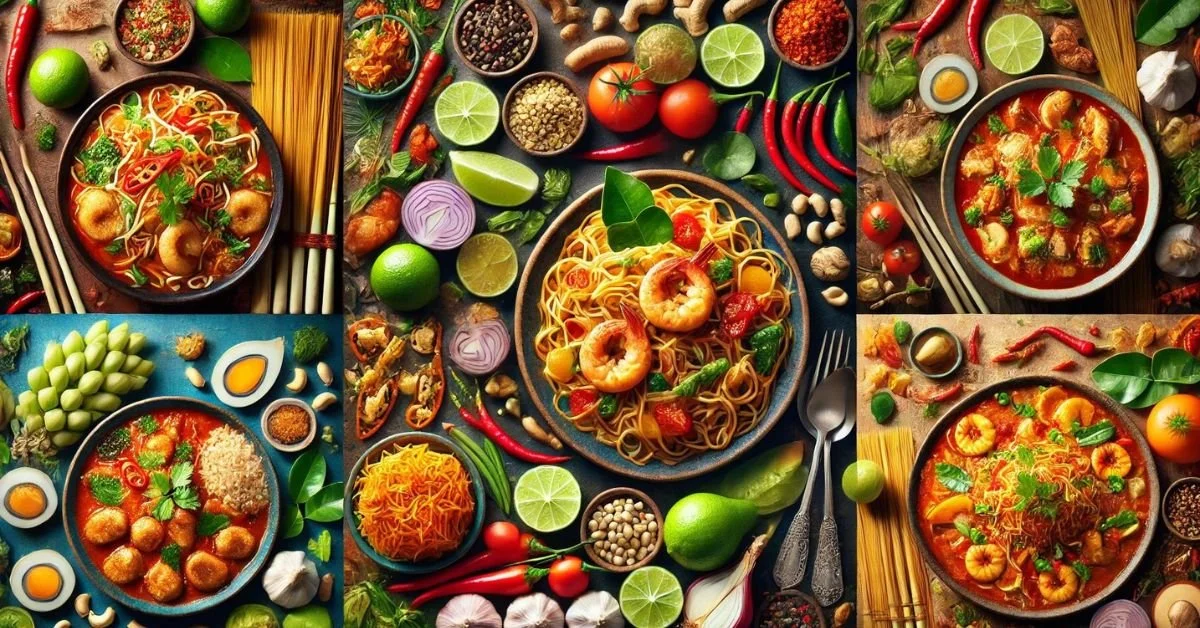A Culinary Journey Through Thailand: Regional Thai Dishes
Thailand’s culinary heritage is deeply tied to its regions, each offering its own unique flavors and traditions. From the mountainous North to the coastal South, the food varies widely, reflecting local ingredients and cultural influences. Join us on a flavorful journey through Thailand’s distinct regions, where we’ll explore Northern, Central, Southern, and Isaan cuisine, highlighting iconic dishes like Khao Soi, Pad Thai, and Massaman Curry.
1. Northern Thai Cuisine: The Comforting Flavors of the Highlands
Northern Thailand’s cuisine is heavily influenced by its cooler climate and neighboring Myanmar and Laos. The food is hearty, with a focus on herbs and sticky rice as a staple. Dishes tend to be milder in spice but rich in flavor.
Khao Soi: This Northern Thai curry noodle dish is famous for its creamy coconut-based broth. Egg noodles are served in a flavorful curry sauce, topped with crispy noodles, and garnished with pickled vegetables and shallots, creating a comforting and satisfying meal.
Sai Ua: A grilled sausage packed with herbs like lemongrass, kaffir lime leaves, and turmeric, Sai Ua is a signature dish of Northern Thailand, often enjoyed with sticky rice and fresh vegetables.
Northern cuisine emphasizes simplicity, with dishes that are filling and fragrant, often featuring a blend of savory, sweet, and herbal flavors.
2. Central Thai Cuisine: The Balance of Flavors
Central Thailand, home to the bustling capital of Bangkok, offers a diverse array of dishes that strike a perfect balance between sweet, sour, salty, and spicy. The fertile plains provide an abundance of fresh produce, and jasmine rice is the region’s main carbohydrate.
Pad Thai: This internationally famous dish consists of stir-fried rice noodles, eggs, tofu, shrimp or chicken, and a tamarind-based sauce. Topped with crushed peanuts, lime wedges, and bean sprouts, Pad Thai is a perfect harmony of sweet, sour, and savory flavors.
Tom Yum Goong: A bold, spicy shrimp soup, Tom Yum Goong is a perfect example of Central Thailand’s penchant for blending hot and sour flavors. The broth, infused with lemongrass, galangal, and lime juice, is both refreshing and fiery.
Central Thai cuisine exemplifies the art of balancing flavors, making it one of the most complex and beloved styles of Thai cooking.
3. Southern Thai Cuisine: Bold, Spicy, and Coconut-Rich
Southern Thailand’s cuisine is known for its intense spiciness and the heavy use of coconut milk, thanks to the region’s tropical climate and access to the sea. Dishes often feature seafood and aromatic spices, influenced by Malaysian and Indian culinary traditions.
Massaman Curry: Originating from Southern Thailand, Massaman Curry is a unique blend of Thai and Indian flavors. Made with chicken or beef, potatoes, peanuts, and a mix of spices like cinnamon and cardamom, this mild, slightly sweet curry is rich and aromatic, perfect for those who enjoy bold yet comforting flavors.
Gaeng Som (Sour Curry): This fiery, sour curry is made with fish or shrimp, tamarind, and turmeric, and is typically served with jasmine rice. The intense heat of this dish is balanced by the tanginess of the tamarind, making it a must-try for spice lovers.
Southern Thai cuisine is a celebration of bold flavors, often featuring coconut milk to temper the heat, along with fresh seafood and tropical fruits.
4. Isaan Cuisine: The Bold, Rustic Flavors of the Northeast
Isaan, the northeastern region of Thailand, is known for its simple yet intensely flavorful dishes, often characterized by their spiciness and use of fermented ingredients. Sticky rice is a staple here, and grilled meats, fresh salads, and pungent fish sauces are common elements of the cuisine.
Som Tum (Papaya Salad): A classic Isaan dish, Som Tum is a refreshing salad made from shredded green papaya, chilies, tomatoes, peanuts, and lime juice. It perfectly balances spicy, sour, and salty flavors, often enjoyed with sticky rice and grilled chicken.
Larb: Larb is a minced meat salad, typically made with pork or chicken, seasoned with lime, fish sauce, herbs, and toasted rice powder. This dish is fiery and packed with bold flavors, and is often served alongside fresh vegetables and sticky rice.
Isaan cuisine is known for its rustic simplicity and powerful flavors, with dishes that are deeply satisfying and designed to be shared.
Conclusion: A Journey of Flavor and Tradition
Thailand’s regional cuisines offer a diverse and exciting culinary adventure. From the comforting warmth of Northern Khao Soi to the fiery punch of Isaan’s Som Tum, each region brings something unique to the table. Whether you’re a fan of bold spices or prefer milder, coconut-based curries, Thailand’s cuisine promises to delight your taste buds with every bite.
Exploring regional Thai dishes is more than just a culinary experience—it’s a way to connect with the history, culture, and traditions of this vibrant country. So, the next time you’re in Thailand or cooking Thai food at home, take a moment to savor the regional flavors that make this cuisine so extraordinary.
